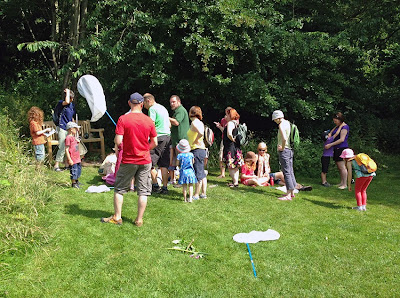Opening the moth traps
Reserve warden Steve Warrillow made us very welcome, as always. First, Steve suggested we open the moth traps. It's always exciting, because you never know what you might find! The most abundant moth we found was the Poplar Hawk-moth, just as it was at our last event at Rodley Nature Reserve.
Poplar Hawk-moth
There were plenty of moths in the traps, and the two most beautiful were probably the Buff Arches and the Burnished Bronze.
Burnished Brass moth
Next up was... Bug hunting! We were kitted out with large butterfly nets and sent around the reserve to catch anything that moved (or didn't move, for that matter). We found several Harlequin Ladybirds, including their tiny larva. The larval stage of a insect in the stage between the eggs and the full grown adults, such as caterpillars (butterflies and moths), maggots (flies), and those scary-looking creatures in ponds that become dragonflies.
Bug hunting
We found the larva of the Peacock butterfly, which feed on nettles. These are striking black caterpillars with spangly silver stars on them.
Peacock butterfly larva
We also caught some Ringlets (small dark butterflies with pretty ring shapes on their wings), soldier beetles, and all kinds of other tiny bugs.
As we walked around the reserve Steve explained to us about Himalayan Balsam, a plant introduced into the Britain which doesn't really belong here. It grows here so well that it takes all the space a light, making it difficult for other plants to grow. They have attractive flowers, but many nature reserves have to remove them to help our native plants.
Steve explains why we have to remove Himalayan Balsam
Finally we did some brilliant pond dipping. Amongst the many creatures we found were water boatmen, diving beetles, damselfly larvae, leeches, tadpoles, froglets, and tiny young smooth newts. The young newts have feathery plumes at the side of their heads. These are their gills, which will be replaced by internal lungs (like ours) when they become adults.
Pond dipping
All the while a young Moorhen called out from the pond, and a fantastic Brown Hawker (a type of large dragonfly) zoomed around over our heads. Cam found the skin of a Brown Hawker nymph, possibly from the very dragonfly we could see flying around. This skin cast (called an exuvia) is the skin of the dragonfly while it's underwater in its larval (or nymph) stage. The dragonfly nymph crawls out of the water a pushes itself out of the old skin and pumps up its wings to become a fully adult dragonfly.
The skin of a Brown Hawker nymph
Thanks again to all the children and parents who came along. The Airedale Otters now have their annual break for the summer holidays. Our next event is a Bat Walk at St Ives, Bingley, on Saturday 14th September.
In the meantime we hope you all have a great summer holiday, and hopefully find lots of interesting wildlife on your travels or closer to home. Please bring any interesting stories or items you've found to our next event. Why not keep a nature scrapbook, recording any the interesting wildlife you see? Here's one we've started at Airedale Otters HQ:
Why not keep a nature scrapbook like this one?











No comments:
Post a Comment